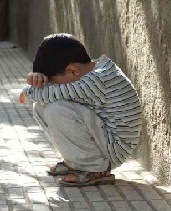Self Injury

Learn ways to deal with child self injury, also known as self injurious behavior (SIB). Self abuse can be very disturbing for parents to witness. Your first thought is to immediately approach your child and get them to stop engaging in this behavior.
However, it is possible that this could make things worse. Because I am unable to assess your specific situation the tips I am going to provide may not necessarily help your exact situation.
There are many different possible causes of self injurious behavior. The best way to determine how to eliminate a problem with self abuse is to figure out why the child is doing the behavior.
This may be easier with an older child that can communicate well, but for self injury in autism or younger children, you may want to seek professional help first.
If your child is displaying frequent and severe self injurious behavior it is highly recommended that you seek professional help immediately. DO NOT APPLY THESE TECHNIQUES WITHOUT SUPERVISION OF A TRAINED PROFESSIONAL FOR SEVERE OR FREQUENT SELF INJURY.
For the occasional incidents of mild intensity the following tips can be helpful.
Causes of Self Injury
1. Pain. Self abuse can sometimes be a sign of pain, especially for a child that has difficulty communicating or that is diagnosed with a pervasive developmental disorder. Observe the exact location of abuse and investigate whether it is possible that the child may be in pain. If the child is hitting his or her head or ear, try to determine if maybe they are suffering from a headache or earache.
You may want to ask if your child hurts or use the sign for pain while pointing to the area. Whatever method of communication you would typically use or if you are using a picture exchange communication system (PECS) , try to create a picture for pain to help them become familiar with this concept. If you believe your child is in pain, contact your pediatrician or family doctor for further instruction.
2. Attention seeking behavior. Self injurious behavior can also occur as a way to get attention. If you notice that the child tends to head bang or do other types of injurious behavior usually when alone and someone frequently goes over to give them attention immediately after the behavior, then attention is probably the motivator. Putting the child on a schedule of frequent attention every 5-10 minutes can help with this. You may also find additional strategies for attention seeking behavior at the link above.
3. Access to desirable items. Some children will learn that when they can't have something they often gain access to preferred items after hurting themselves. Self abuse for this reason can be very tricky. If you try to withhold the items following self abuse you will risk an escalation leading to severe injury. You may find some of the tips on how to say no to be helpful, but seek help from a professional if you suspect this is the problem.
4. During transition times. Some children might engage in self injurious behavior to avoid transitioning to a new activity or to avoid and/or delay undesirable activities. Applying the transition strategies provided at the link above can help with a problem due to this reason.
5. Automatic reinforcement (self-stimulation). Automatic reinforcement from injurious behavior results in the release of endorphins and dopamine in the brain, both associated with feelings of well being and enjoyment. This may be especially relevant in cases where a child may be in an undesirable situation or not feeling well.
6. Self-Regulation. It may also be helping a child to achieve self-regulation if the child suffers from sensory processing disorder. Working with an occupational therapist to develop a sensory diet and implement other sensory regulation activities can help to prevent self injury due to this reason.
7. Escape from undesirable activities. A child that doesn't want to do something that is asked might discover that self injury stops requests to do things. Compliance strategies can help to avoid injurious behavior due to this reason, but additional professional assistance may be needed if the behaviors are frequent or severe.
Additional Interventions
Depending on your specific situation, if you are unsure of the reasons, it might be necessary to have a trained professional observe to establish the function of the behavior through an assessment in order to help you determine what the best treatment interventions are for your child.
For some situations a protective helmet for head banging or other protective gear may be recommended to help decrease the chances of injury resulting from the behavior.
You may try to have your child engage in certain activities continuously, that occupy hands as a method of preventing self injury to your child's hands (hand biting) or injuries caused by your child's hands (hitting a body part or skin picking). Some activities may include manipulative toys
, such as a rubics cube or a squeeze ball, depending on the child's preference.
For older children that are engaging in self injury cutting, seek professional help immediately. Getting them into a support group and seeking help from a trained professional is the best solution.
Avoid trying to talk to your child yourself as it's possible you may make the problem worse by directly bringing attention to it. It is better to get outside help for these types of situations.
Just a reminder that if your child is displaying frequent and severe self injurious behavior it is highly recommended that you seek professional help as soon as possible. DO NOT APPLY THESE TECHNIQUES WITHOUT SUPERVISION OF A TRAINED PROFESSIONAL FOR SEVERE OR FREQUENT SELF INJURY.
Return to Behavior Intervention Plans page
Return to Home from Self Injury page